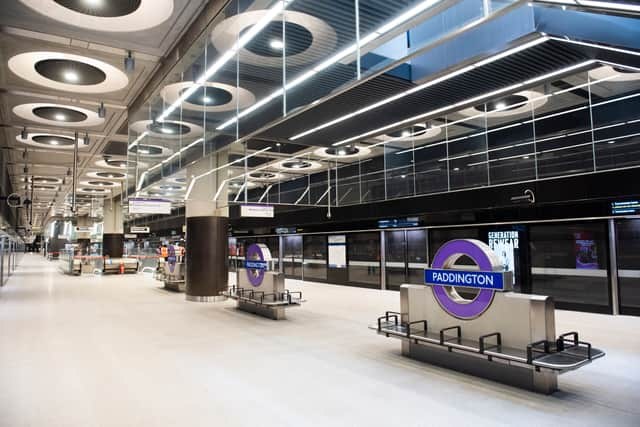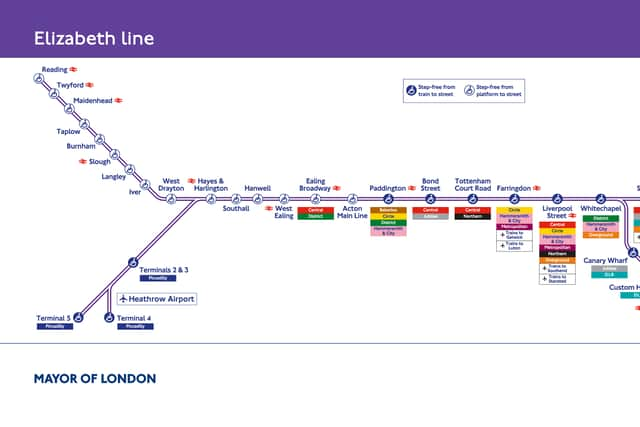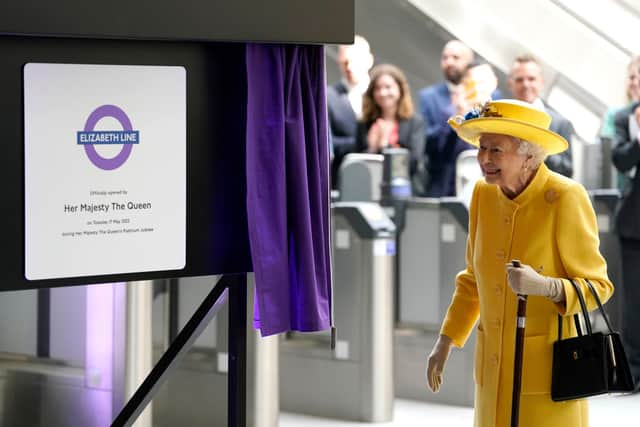Crossrail’s 80 years in the making: The history behind the Elizabeth line
and live on Freeview channel 276
Commuters and passengers in London are finally able to enjoy the new Elizabeth line after years of delays.
It was described as a “historic” day for Londoners, despite teething issues that saw passengers evacuated from the Paddington site at 9am, just hours after the line opened.


Advertisement
Hide AdAdvertisement
Hide AdThe line runs from Abbey Wood and Shenfield in the east to Reading and Heathrow Airport in the west.
However the Elizabeth line has actually taken longer to get here than you might expect, with the first ideas being discussed 80 years ago.
History of the Elizabeth Line
The history of the Elizabeth Line has been provided by Jago Hazzard who produces YouTube videos around London transport.
In the 1930s, the transport system in London became overcrowded and London Transport, which is now TfL, had ideas to build new underground express lines.
Advertisement
Hide AdAdvertisement
Hide AdJago explained: “During the Second World War they started the building work for these plans, which included them considering using the nuclear bunker under Chancery Lane Station as a possible stop.
“In 1943, a County of London plan was put in place after an investigation into how post war London should be reconstructed.
“This new plan included four new railway lines to run around London with a focus on Orbital routes, including a Circle Line express route.
“There were also plans for a line that would run from New Cross, up to the West End and then back down to Clapham.”
Advertisement
Hide AdAdvertisement
Hide AdIn 1946, the Abercrombie report was published that was more detailed and with more complicated rail routes.
This included Route 5 which would run from the south east to Royal Oak near Paddington - which broadly mirrors the current Elizabeth line route.
However in the 1946 Abercrombie report, none of the proposed lines ran through the Docklands - as the new Crossrail route does - which was because at the time this wasn’t the financial hub of Canary Wharf.


A London Rail Study report was released in 1974 and the term Crossrail was first used.
Advertisement
Hide AdAdvertisement
Hide AdJago said: “This report also specifically identified a new line that would run from Liverpool Street to Paddington.
“Although this is believed to be the basic beginning concept to the Elizabeth line, the stops were slightly different with a proposal to run through Holborn, Leicester Square, Bond Street and Marble Arch.”
In 1989, the Department of Transport put out a study called the Central London Rail Study that detailed a number of new schemes.
These proposed the likes of the Jubilee Line extension and the ThamesLink Metro which did get developed from this study.


Advertisement
Hide AdAdvertisement
Hide AdThere were also a number of Crossrail lines that were proposed which included a version of the “Elizabeth line” from the 1974 London Rail Study.
The route was projected to run from Shenfield in the east over to Heathrow and Slough in the West.
This was different to the final Elizabeth line route, with it also being proposed to run from Enfield and not mentioning running to Reading.
The Crossrail Bill was submitted to Parliament in 1991 as a joint venture between the London Underground and the British Railways Board.
Advertisement
Hide AdAdvertisement
Hide AdDuring this time, an alternative route was suggested by the Residents Association of Mayfair that proposed the line be sent North via Marylebone and Euston.
Despite the plans of running this as a regular rail route, the Crossrail Bill described the new line as a “Tube line”.
The Crossrail Bill was rejected in 1994 due to the recession that had seen a downturn in passenger numbers.
However, this is a frequent pattern of rail travel, where numbers will dwindle but pick up again and cause travel chaos as there’s not enough trains on the lines.
Advertisement
Hide AdAdvertisement
Hide AdThis was the case in 2000 when passenger numbers significantly rose again and so the Crossrail plans were reintroduced.
The planning finally began in 2005 with the stations planned between Liverpool Street and Paddington to be Farringdon, Tottenham Court Road and Bond Street.
The lines that then fed into the central section hadn’t been completely decided, but were proposed to feed out to Aylesbury and Amersham, Watford Junction, Watford and Uxbridge and High Wymbombe and Richmond in the west.
In the east the possibilities included Shenfield, Tilbury via Royal Docks and Forest Gate and Strood via Charlton.


Advertisement
Hide AdAdvertisement
Hide AdThe Elizabeth line project was finally approved in 2007, and in 2008 the Crossrail Act received royal assent.
On May 15 2009, the construction of the line finally began but faced many delays and budget issues.
The line finally opened to the public on May 24 2022 and at present runs in three sections, which include Reading to Paddington, Paddington to Liverpool Street and Abbey Wood and Liverpool Street to Shenfield.
It is hoped that some of the links will be completed by the Autumn which will enable commuters direct travel from Reading to Abbey Wood and Shenfield to Paddington.
Advertisement
Hide AdAdvertisement
Hide AdBy May 2023 every part of the line should be connected with 24 trains running per hour.
Bond Street is also still not ready for opening but indications from TfL suggest that it may open around August or September.
